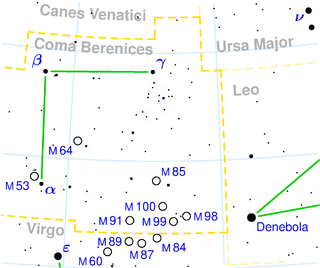Dragonfly 44
| Galaxy Dragonfly 44 (Dragonfly 44) |
|
|---|---|

|
|
| Coma pile | |
| AladinLite | |
| Constellation | Berenike's hair |
|
Position equinox : J2000.0 , epoch : J2000.0 |
|
| Right ascension | 13 h 00 m 58.0 s |
| declination | + 26 ° 58 ′ 35 ″ |
| Appearance | |
| Brightness (visual) | 19.4 mag |
| Angular expansion | 0.17 ′ × 0.58 ′ |
| Physical data | |
| Affiliation | Coma galaxy clusters |
| distance | ~ 3.3 · 10 8 ly |
| Absolute brightness | (vis) [D7Jan15] -15.7 ± 0.2 mag (vis) [D1Mai15] -16.1 mag |
| Dimensions | ~ 10 12 M ☉ |
| diameter | 70,000 ly |
| history | |
| Discovery date | 2015 |
| Catalog names | |
| SDSS J130057.98 + 265839.6 , SDSS J130058.17 + 265836.1 , SDSS J130058.21 + 265829.3 | |
Dragonfly 44 (German Libelle 44 ) is a galaxy with a very high proportion of dark matter . It is an example of an ultra-diffuse galaxy in the Coma Galaxy Cluster . The measured rotation speed suggests a mass of one trillion solar masses , which corresponds to the mass of the Milky Way . But the light emission of the galaxy is only about 1 % of the light emission of the Milky Way.
The galaxy was originally developed by Pieter van Dokkum ( Yale University ) and his team with the home-built Dragonfly telephoto array discovered and hence the name Dragonfly (dt. Dragonfly ). Dragonfly-44 (DF-44) is one of 47 objects (DF-1 to DF-47) with low surface brightness that Pieter van Dokkum and his team assigned to the Coma galaxy cluster with high probability (published January 2015). DF-44, the largest of these objects, was observed with the Keck Observatory and its membership of the Coma galaxy cluster was verified spectroscopically (publication May 2015).
After additional investigations with the Gemini observatory , the discoverers came to the conclusion that with DF-44 the proportion of dark matter within the “light” interior area is 98 % (published August 2016). The mass of the interior is estimated at 7 · 10 9 solar masses ; this inner area is surrounded by a halo of dark matter, with the total mass of the galaxy being estimated at ~ 10 12 solar masses, so that the proportion of dark matter is over 99.9%. However, it is not clear whether there is dark matter.
See also
Notes and individual references
- ↑ a b c d Van Dokkum, Pieter et al .: Spectroscopic confirmation of the existence of large, diffuse galaxies in the coma cluster . In: The Astrophysical Journal Letters . May 1, 2015. Accessed September 1, 2016.
- ↑ a b Van Dokkum, Pieter et al .: Forty-seven milky way-sized, extremely diffuse galaxies in the Coma-Cluster . In: The Astrophysical Journal Letters . January 7, 2015. Accessed August 31, 2016.
- ↑ corresponds to a viewing angle of 0.012 °
- ↑ Researchers discover the “dark Milky Way”. (Article on www.orf.at from August 26, 2016)
- ↑ Researchers discover "dark Milky Way" - cousin of our galaxy. (Article on heise.de from August 26, 2016)
- ↑ Scientists discover the fluffiest galaxies . phys.org. May 14, 2015.
- ↑ Dragonfly 44 is located with a galactic latitude of b = 87.873 ° (galactic longitude l = 29.38 °) near the galactic north pole, so that the observation by the Milky Way is less disturbed. The expansion of the galaxy is ~ 70,000 light years, which corresponds to an angular expansion of 0.012 ° at a distance of ~ 330 million light years.
- ↑ The Milky Way's dark twin revealed , Nature News. July 26, 2016. Retrieved July 30, 2016.
- ^ Yale News: Scientists discover a 'dark' Milky Way. (Article on news.yale.edu from August 25, 2016)
-
↑ Ultra-Low Surface Brightness Imaging with the Dragonfly Telephoto Array (PDF file (9.1 MB), from iopscience.iop.org, accessed on September 18, 2016)
Camera see Dragonfly (multi-lens array) (dunlap.utoronto .ca, accessed August 30, 2016). [This combination of lens telescopes has the advantage that there is less scattered light from other light sources for the observation of faint objects with a large field of view.] - ↑ d. H. the area from which half of the light emanates, see also effective radius
- ↑ see abstract of the article Pieter van Dokkum, Roberto Abraham, Jean Brodie, Charlie Conroy, Shany Danieli, Allison Merritt, Lamiya Mowla, Aaron Romanowsky, Jielai Zhang: a High Stellar Velocity Dispersion and ∼100 Globular Clusters for the Ultra-diffuse Galaxy Dragonfly 44 . In: The Astrophysical Journal . tape 828 , no. 1 , doi : 10.3847 / 2041-8205 / 828/1 / L6 , arxiv : 1606.06291v2 .
- ^ A new class of galaxy has been discovered, one made almost entirely of dark matter , The Washington Post . 26th August 2016.
- ↑ A more recent study suggests that the speed of rotation of the galaxies can possibly also be explained without the concept of dark matter, see New Findings Muddy Understanding Of Dark Matter (www.insidescience.org) and Radial acceleration relation in rotationally supported galaxies Abstract ( at Physical Review Letters) or preliminary article (on arxiv.org)
